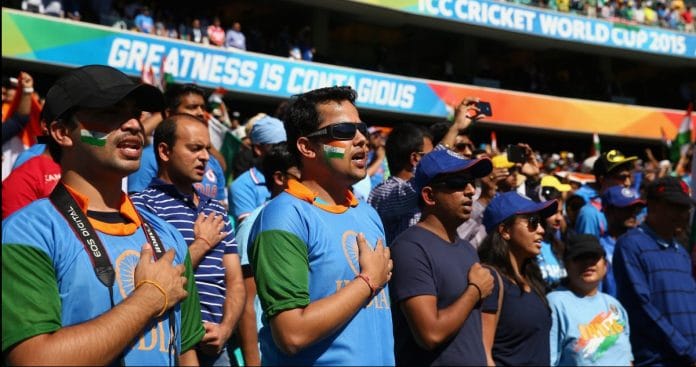The national anthem in cinema halls apparently is the biggest challenge facing the nation today requiring a dozen ministries to work on it.
The national anthem has never had it so good.
Once upon a time the Jana Gana Mana only made the news when someone was dissing it, usually for not being Vande Mataram. For example, RSS leader Bhaiyyaji Joshi said while both songs should be respected, “if one considers the true meaning, then Vande Mataram is the national anthem”.
BJP’s Kalyan Singh used his bully pulpit as the governor of Rajasthan to demand that ‘Jana Gana Mana Adhinayaka He’ be replaced by ‘Jana Gana Mana Mangala Jaya He’ at a university convocation. Adhinayaka, according to an evergreen conspiracy theory, was a paean of praise to the then King Emperor. Rabindranath Tagore himself has denied it, calling it an example of “unbounded stupidity” but conspiracy theories usually are.
But these days it’s achhe din for the old song. The Supreme Court is ruling on it. And then ruling on it again. Now, the government is setting up a 12-member inter-ministerial committee to take a call on playing the national anthem in cinema halls and submit a report within six months. This apparently is the biggest challenge facing the nation today requiring a dozen ministries to work on it. The home and the defence ministries, among others, will figure out its fate in cinema halls.
Tagore, a man who always had an uneasy relationship with chest-thumping nationalism, must be squirming somewhere that his song has become a litmus test for performance patriotism.
The court has now opined what most of us knew by common sense. Patriotism comes from within. It cannot be imposed externally like a layer of makeup. And it certainly does not come from 52 seconds in the dark in a cinema hall with a fluttering CGI tricolour on screen. But finally, the government is seeing the light in the darkened cinema hall. The government’s own attorney-general K.K. Venugopal has urged the court to make it optional. “Your lordships cannot conceive of the thousands of ways it can be misused,” said Venugopal.
But, we can. It’s baffling that the government could not see what was blindly obvious to everyone else. That the law would be abused was always a no-brainer because what we have in this country are plentiful examples of too much goondagardi in the name of patriotism. When cow protectors pride themselves on being vigilantes lynching a Muslim dairy farmer transferring cows, when a mob led by a local politician bursts in on family in the middle of a Hindu-Muslim marriage to “investigate” love jihad, it should hardly come as a surprise that the Jana Gana Mana too can become a handy excuse for beating up those deemed insufficiently patriotic.
The issue has falsely been turned into a debate of to-stand or not-to-stand. “If people can wait at the restaurants, stand in the queues in front of the cinema halls or at the party venues, why cannot they stand for 52 seconds for the national anthem in the cinema halls,” asks Anupam Kher. But it’s not really about that at all. The vast majority of Indians have no problems standing for their national anthem or anyone else’s for that matter. The issue here is different and two-fold.
Why should a cinema hall, a place of entertainment, be the venue for a patriotism booster shot?
And should a person who is not standing for the anthem but not preventing anyone else from doing so, be roughed up in the name of Bharat Mata?
The court has now noted that “we don’t have to wear patriotism on our sleeves.” But after six months of doing just that have we become a more patriotic nation? And would a cinema hall that decides to take the court at its word and stop playing the anthem risk being blacklisted as anti-national?
Through the brouhaha over the national anthem and the national song, we have conclusively established one thing. Those who protest the loudest about patriotism tests via the national anthem or national song, are the ones most likely to be hoist on their own petard. Sometimes we forget we must practise what we preach or in this case what we want others to sing.
In the US, Donald Trump, faced with kneeling protests by athletes during the Star Spangled Banner appointed himself the guardian of the national anthem. Now he has to face the music as he has been caught apparently garbling the song himself at a soccer game in Atlanta, at a loss for its words. “You would think that a man who ran on a platform of pure patriotism and who spent months lecturing athletes about respecting the national anthem, would, at the very least, know the words to the anthem,” said late night show host Seth Meyers.
Trump could get some sympathy from BJP spokesperson Navin Kumar Singh who must remember trying to tackle Vande Mataram, a song he wanted everyone else to sing to prove their deshbhakti. Singh’s facepalm version went something like this:
Vande Mataram
Sujlaam
Blah
Blah
Pulkistan
Sumita Dhumal
Tsunami
Suhasini
Vande Mataram.
Before Singh, BJP’s Maharashtra MLA Raj Purohit who wanted the song to be made compulsory in all schools could only manage two mangled lines. UP minister Baldev Singh Aulakh impressively filibustered for almost six minutes of television to avoid singing four lines of the song.
The purpose of a national anthem or a national song is to inspire pride, to give us goosebumps when we hear the first stirrings of it. In the name of respecting it, we have chosen to make it a political football on talk shows, we have pitted Jana Gana against Vande Mataram. Instead of singing the song ourselves, we are more interested in policing who is not standing.
While we are at it, perhaps the 12-member inter-ministerial committee could also mandate better CGI for our flag?
Sandip Roy is a journalist, commentator and author.






